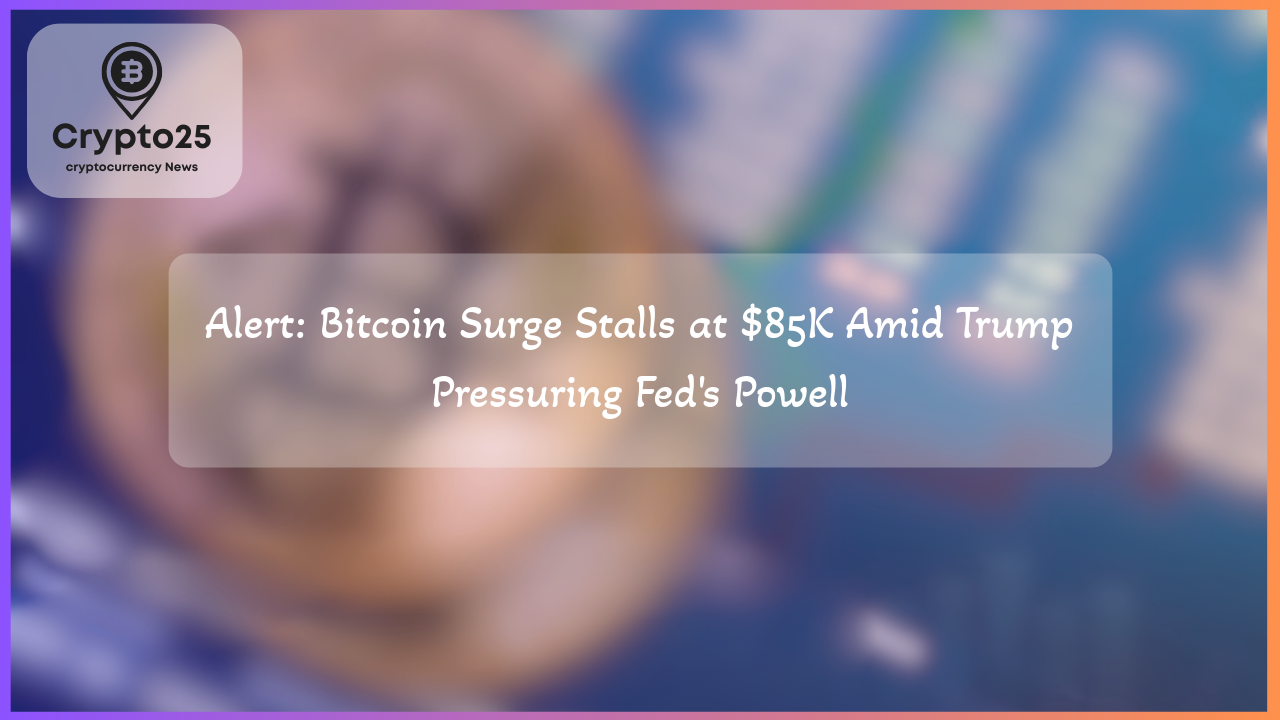
Bitcoin (BTC) trades just shy of $85,000 as global investors navigate uncertainties spurred by rising geopolitical tensions and economic challenges. With central banks adopting divergent policy strategies and Wall Street experiencing volatility, the crypto market remains a focal point for traders weighing their options. BTC, along with major altcoins, showcases resilience, reflecting how digital assets are increasingly becoming reliable hedges in uncertain financial climates.
## Bitcoin’s Price Holds Steady Amid Central Bank Uncertainty
As Bitcoin hovers in the $83,000 to $86,000 range, its price trajectory has captured the market’s attention once again. The cryptocurrency’s steady performance comes during a time of global economic turmoil. On Thursday, Federal Reserve Chair Jerome Powell’s hawkish notes against U.S. policies—particularly addressing the long-standing tariff debates—highlighted potential risks of stagflation, including a slowing economy and rising inflation. In response, markets displayed mixed reactions, with the S&P 500 and Nasdaq indexes trading mostly flat.
Meanwhile, BTC’s stability contrasts with the shakiness of traditional markets. Traders are boosting their confidence in cryptocurrency assets as global monetary approaches diverge. The European Central Bank (ECB) announced its seventh consecutive rate cut, citing a bleak economic growth outlook. This move further cemented Bitcoin’s appeal as a hedge against depreciating fiat currencies, encouraging more investors to adopt crypto-backed strategies. Still, the market remains cautious, with volatility emerging across prediction platforms like Polymarket, where odds of U.S. governance changes in monetary leadership rose to a yearly high of 19%.
## How Central Bank Policies Impact Bitcoin Investors Globally
Central bank actions significantly influence Bitcoin’s position as a non-sovereign asset class. Jerome Powell’s ongoing feud with U.S. President Donald Trump, fueled by the Federal Reserve’s firm stance on combating inflation, further underscores the independence debate surrounding central banking institutions. Additionally, speculation over Trump’s intent to replace Powell has injected a dose of fear among financial analysts. Figures like Treasury Secretary Scott Bessent have voiced concerns about such a move, warning that political intervention in the Federal Reserve may lead to unprecedented fluctuations in the already fragile U.S. markets.
This growing uncertainty seems to benefit Bitcoin. As faith in traditional financial systems wanes, investors amplify their participation in decentralized financial ecosystems, where assets like BTC and Ethereum (ETH) thrive. Notably, BTC and ETH prices both experienced modest gains of 0.8% within the last 24 hours, signaling a progressive departure from stock market risk sentiment and a tilt towards blockchain-backed investments.
| Title | Details |
|---|---|
| Market Cap | $1.2 Trillion |
In Europe, the ECB’s rate-cut decisions emphasize the bloc’s attempt to combat sluggish growth, which may inadvertently weaken the euro. For global investors, these developments present opportunities for Bitcoin to emerge as an internationally accepted monetary standard less influenced by political constraints.
## Bitcoin Traders Adopt Multifaceted Strategies
While Wall Street grapples with economic turbulence, Bitcoin traders are demonstrating strategic adaptability. On cryptocurrency options exchange Deribit, traders continue positioning themselves for potential movements on both sides of the BTC price spectrum. Bullish sentiment is evident, notably through increased demand for call options at $90,000 to $100,000, set to expire in upcoming months such as May and June. This optimism aligns with the broader market belief that Bitcoin’s current momentum may extend amid accumulating institutional interest.
Interestingly, the derivatives data reflects a hedged approach. Amid calls for upward price action, traders are also increasing their purchases of put options—particularly those tied to an $80,000 price floor. These insurance-like instruments showcase an awareness of macro instability, with buyers preparing for potential price corrections while profiting from market swings. The battle between bullish and bearish positions maintains a balanced but cautious market outlook.
Adding to this complex environment is Wall Street’s “fear gauge,” the CBOE Volatility Index (VIX). Despite a decline from recent highs, the index remains above its 50-day moving average, signaling persistent uncertainty. The elevated VIX underscores traders’ collective belief: while Bitcoin gains traction, macro conditions remain unsettled, prolonging risk hedging for crypto investors.
Bitcoin’s status as a decentralized and politically neutral store of value sets it apart in times like these. While traditional assets continue to traverse uncertain waters, many investors, both institutional and retail, view cryptocurrency as a long-term shield against monetary instability. This ongoing shift not only solidifies Bitcoin’s foundational role in the modern financial landscape but also paves the way for broader mainstream adoption as markets globally recalibrate to fresh realities.
